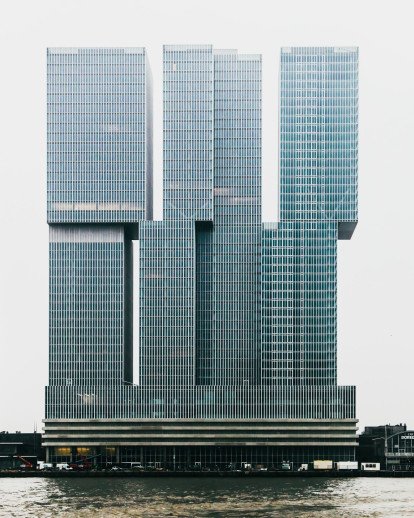Crabs on LSD
Koolhaas presented so many ideas and witty remarks in his text about Junkspace that it's hard to know where to begin. I will say right off the bat that I appreciated his metaphors, "there is no progress; like a crab on LSD, culture staggers endlessly sideways." Although he was off on another tangent, I think it reinforces his earlier statement about building materials and the rejection of regularity; although culture shifts to seeing repetition as oppressive, technology is making the way we construct more modular and repetitious with prefabrication. So is technology is stifling the creative outlet and therefore the reason we can't progress?

Throughout the whole text, I was constantly thinking of the connections within the text but also with his built projects. For example, he mentions "transparency only reveals everything in which you cannot partake," and then later states that, "transparency has disappeared, to be replaced by a dense crust of provisional occupation." A great connection since he was then speaking about aging and renovations. We are apart of that and are directly affected by the new circulation patterns and way-finding associated with interior renovations.
In regard to connections with his own work, there were so many instances in which I thought, "uh doesn't he do this in his projects?" So is he for Junkspace or against it? Simply based on the number of connections I found within the text and what he has done in practice, I think he is for Junkspace. Or rather, he is so fascinated by the concept that he challenges himself to work with it in a more beautiful and organized way, like organized congestion. So is this progress in his mind? Are his projects just crabs on LSD or are they better because he works with Junkspace purposefully?


Throughout the whole text, I was constantly thinking of the connections within the text but also with his built projects. For example, he mentions "transparency only reveals everything in which you cannot partake," and then later states that, "transparency has disappeared, to be replaced by a dense crust of provisional occupation." A great connection since he was then speaking about aging and renovations. We are apart of that and are directly affected by the new circulation patterns and way-finding associated with interior renovations.
In regard to connections with his own work, there were so many instances in which I thought, "uh doesn't he do this in his projects?" So is he for Junkspace or against it? Simply based on the number of connections I found within the text and what he has done in practice, I think he is for Junkspace. Or rather, he is so fascinated by the concept that he challenges himself to work with it in a more beautiful and organized way, like organized congestion. So is this progress in his mind? Are his projects just crabs on LSD or are they better because he works with Junkspace purposefully?



I think there is some sense of "betterment" in his projects because although he may in many ways also be producing junkspace there is probably more thought and purpose into what he is doing that in what he is learning from. He's trying to form junkspace into something else almost.
ReplyDeleteI don't think that technology is necessarily "stifling the creative outlet" I think the way men choose to use technology might be doing so. For example the way Zumthor uses technology is anything but repetitive. He takes advantage of it to create uniquely designed and crafted details for his buildings.
ReplyDeleteI do believe he creates some of the Junkspace he remarks on. I remember one point in the reading he mentioned ramps moving horizontally in various directions, which I'm pretty sure is a reflection on projects such as Seattle Library. The best I could gather with Junkspace is that it lacks order or reason
ReplyDelete